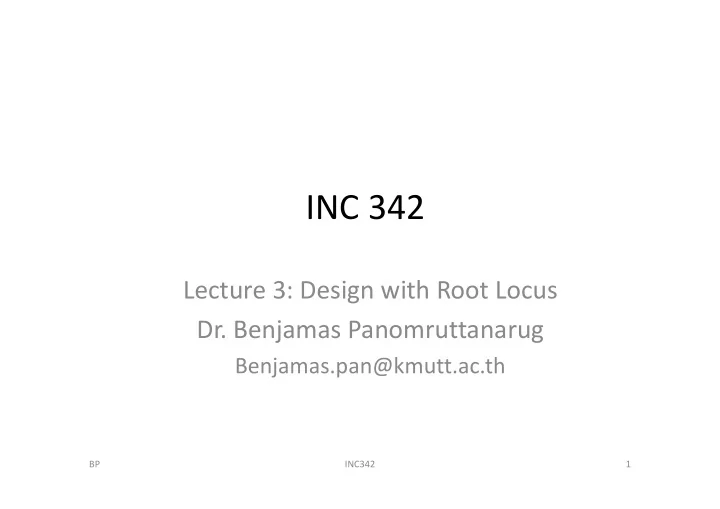

INC 342 Lecture 3: Design with Root Locus Dr. Benjamas Panomruttanarug Benjamas.pan@kmutt.ac.th BP INC342 1
Review • Gain adjustment: – Calculate Max. K that still makes the system stable – Design K to get a desired damping ratio BP INC342 2
Compensator • Allows us to meet transient and steady state error. • Composed of poles and zeros. • Increased an order of the system. • The system can be approx. to 2 nd order using some techniques. BP INC342 3
Types of compensator 1. Active compensator – PI, PD, PID use of active components, i.e., OP ‐ AMP – Require power source – ss error converge to zero – Expensive 2. Passive compensator – Lag, Lead use of passive components, i.e., R L C – No need of power source – ss error nearly reaches zero – Less expensive BP INC342 4
Improving steady ‐ state error using compensator Placing a pole at the origin to increase system order; decreasing ss error as a result!! BP INC342 5
The pole at origin affects the transeint response adds a zero close to the pole to get an ideal integral compensator BP INC342 6
Example Choose zero at ‐ 0.1 Damping ratio = 0.174 in both uncompensated and PI cases BP INC342 7
• Draw root locus without compensator • Draw a straight line of damping ratio • Evaluate K from the intersection point • From K, find the last pole (at ‐ 11.61) • Calculate steady ‐ state error BP INC342 8
• Draw root locus with compensator (system order is up by 1 ‐‐ from 3 rd to 4 th ) • Needs complex poles corresponding to damping ratio of 0.174 (K=158.2) From K, find the 3 rd and 4 th poles (at • ‐ 11.55 and ‐ 0.0902) • Pole at ‐ 0.0902 can do phase cacellation with zero at ‐ 1 (3th order approx.) • Compensated system and uncompensated system have similar transient response (closed loop poles and K are aprrox. The same) BP INC342 9
Comparison of step response of the 2 systems BP INC342 10
PI Controller K 1 K s 1 K K 2 2 ( ) G c s K 1 s s BP INC342 11
Example K = 164.6 in P controller and K = 158.2 in PI controller BP INC342 12
SS response improvement conclusions • Can be done either by PI controller (pole at origin) or lag compensator (pole closed to origin). • Improving ss error without affecting the transient response. • Next step is to improve the transient response itself. BP INC342 13
Recommend
More recommend